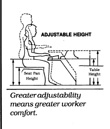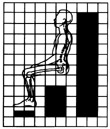The Economics of Ergonomics
What is Ergonomics?
Simply stated, ergonomics is the study of the relationship between workers and the work environment. It encompasses virtually every element of the office - from the physical surroundings of furniture and lighting to the organization of routine tasks. Just about anything that can impact on-the-job performance falls within the realm of ergonomics.
Design the office around the worker.
The main objective of ergonomics is to keep workers happy, healthy, and productive. And the easiest way to accomplish that goal is to design the office environment with the employee in mind from the outset. How many hours will the worker be in front of a video display terminal (VDT)? What percentage of the day does the employee sit/stand? Can certain tasks which require leaving an individual workspace be scheduled intermittently throughout the day to provide regular breaks? Finding answers to these and many other questions can help you find sound ergonomic solutions.
Why Should you be concerned about Ergonomics?
Your company could not only suffer from lower productivity, but your employees could also suffer serious, debilitating injuries from office related Cumulative Trauma Disorders. These are caused by prolonged repetitive motion, such as a data entry operator would experience working at a keyboard five days a week.
The most common CTD, or at least the one making the most headlines, is Carpal Tunnel Syndrome (CTS). This painful condition is caused by repetitive wrist-hand motion which irritates the tendons in the wrist. These tendons then swell, compressing the median nerve which runs through the same narrow channel in the wrist - the carpal tunnel. The pressure on the median nerve causes tingling, numbness, and severe pain in the wrist and hand. CTS pain can be so severe that sufferers are totally unable to perform their job functions.
The most common CTD, or at least the one making the most headlines, is Carpal Tunnel Syndrome (CTS). This painful condition is caused by repetitive wrist-hand motion which irritates the tendons in the wrist. These tendons then swell, compressing the median nerve which runs through the same narrow channel in the wrist - the carpal tunnel. The pressure on the median nerve causes tingling, numbness, and severe pain in the wrist and hand. CTS pain can be so severe that sufferers are totally unable to perform their job functions.
CTDs can hurt your bottom line, too.
It may seem strange that an employee could be disabled from simply working at a computer workstation, but the facts are clear - CTDs can be utterly crippling. And, if the condition is not diagnosed and treated early, lengthy physical therapy rehabilitation and even surgery may be necessary.
Employees suffering from CTDs are entitled to file workman's compensation claims. So, you not only lose the services of valued employees, but you also risk substantial increases in your required contributions to workman's compensation funds. Your insurance premiums would likely go up as well. In addition, you could be held liable if an employee's condition deteriorated to the point that they were left unable to work in their chosen profession.
Employees suffering from CTDs are entitled to file workman's compensation claims. So, you not only lose the services of valued employees, but you also risk substantial increases in your required contributions to workman's compensation funds. Your insurance premiums would likely go up as well. In addition, you could be held liable if an employee's condition deteriorated to the point that they were left unable to work in their chosen profession.
Ergonomics is not a fad.
As the business world becomes more and more reliant on computers for day-to-day operation, workers will continue to spend more and more time in front of VDTs. The combination of lower productivity and health risks from CTDs should make good ergonomic design a priority concern for businesses of all sizes.
What are the major components of good Ergonomic design?
Consideration should be given to any environmental factor that could affect a worker's ability to focus and concentrate on the task at hand, with special attention paid to those elements that could cause injury.
Environment
Noise
Telephone conversations in a noisy "bullpen" office can be almost impossible. In many situations, simply dividing the office into zones (based on printer usage, phone usage, meeting areas, etc.) can alleviate much of the problem. In more extreme cases, acoustic tiles and panels can be installed on the ceilings and walls to baffle reflected sound.
Lighting Glare from overhead lighting and windows can reflect off computer screens directly into the eyes of the users. This is not only annoying, it can also cause eye fatigue and blurred vision. VDT workstations should always be placed parallel to windows and between rows of overhead lights to avoid reflection.
Computer stations generally require less overall light because the computer screen provides its own illumination. User-controllable task lighting should therefore be used to provide adequate light on desktops and other work surfaces.
Telephone conversations in a noisy "bullpen" office can be almost impossible. In many situations, simply dividing the office into zones (based on printer usage, phone usage, meeting areas, etc.) can alleviate much of the problem. In more extreme cases, acoustic tiles and panels can be installed on the ceilings and walls to baffle reflected sound.
Lighting Glare from overhead lighting and windows can reflect off computer screens directly into the eyes of the users. This is not only annoying, it can also cause eye fatigue and blurred vision. VDT workstations should always be placed parallel to windows and between rows of overhead lights to avoid reflection.
Computer stations generally require less overall light because the computer screen provides its own illumination. User-controllable task lighting should therefore be used to provide adequate light on desktops and other work surfaces.
Furniture
Adjustability, adjustability, adjustability.
User adjustability is the single most important issue when considering furniture options. A chair that perfectly suits a 5' 3" woman would be extremely uncomfortable for a 6' 1" man. However, a chair that is completely adjustable would suit them both - an especially important point for companies running more than one shift.
If a chair or desktop can be raised, lowered, and tilted, a worker can adjust it so that it fits. And if it fits, the employee can be comfortable and fully concentrate on performing their job function without the distractions of sore wrists or an aching back.
User adjustability is the single most important issue when considering furniture options. A chair that perfectly suits a 5' 3" woman would be extremely uncomfortable for a 6' 1" man. However, a chair that is completely adjustable would suit them both - an especially important point for companies running more than one shift.
If a chair or desktop can be raised, lowered, and tilted, a worker can adjust it so that it fits. And if it fits, the employee can be comfortable and fully concentrate on performing their job function without the distractions of sore wrists or an aching back.
What Ergonomic solutions are currently available?
Naturally, it's easier to build good ergonomic design into a facility, but there are many good retrofitting solutions available. Major manufacturers have embraced ergonomics and offer a myriad of options.
Seating
A worker's chair is probably the single most important piece of furniture they use all day. It should adjust in as many different directions as is practical.
When seated, the height at the point directly behind the knees (popliteal height) is critical. The popliteal height should be set so that the legs rest on the chair seat and the feet are flat on the floor. The front of the chair's seat should have a rounded front edge or "waterfall edge." Almost all chairs designed for the office incorporate these two features. Chair arms should also be provided for employees who need to rest their elbows and arms while using a keyboard.
Good lumbar support and a seat which can tilt are important options for proper back posture. The backrest should also adjust up and down to correctly position the lumbar support area.
When seated, the height at the point directly behind the knees (popliteal height) is critical. The popliteal height should be set so that the legs rest on the chair seat and the feet are flat on the floor. The front of the chair's seat should have a rounded front edge or "waterfall edge." Almost all chairs designed for the office incorporate these two features. Chair arms should also be provided for employees who need to rest their elbows and arms while using a keyboard.
Good lumbar support and a seat which can tilt are important options for proper back posture. The backrest should also adjust up and down to correctly position the lumbar support area.
Work surfaces
Standard height desktops were not designed for computers. A keyboard on the work surface is too high for most workers, forcing them to excessively elevate their arms and bend their wrists - the exact situation that causes carpal tunnel syndrome. Many desk returns are now built with a shorter surface height to serve as a computer workstation and some desks incorporate a keyboard shelf that slides out from under the desktop at the correct level. The proper height allows the worker's arms to remain parallel to the slight upward angle of the keyboard and the wrists to remain straight.
A desk must also provide ample leg room and sufficient workspace to perform a variety of tasks.
A desk must also provide ample leg room and sufficient workspace to perform a variety of tasks.
Accessories
Many add-on accessories have been developed to alleviate ergonomic shortcomings of older office furniture. Wrist-rests and pads can provide welcome relief to data entry operators, adjustable monitor shelves can put the computer display at the proper
Can Ergonomics really save my company money?
You bet. The difference in productivity alone will justify an ergonomic investment in most office environments. Combined with fewer workman's compensation with fewer workman's compensation claim, lower insurance premiums, and reduced risk of liability, ergonomics can be an extremely effective cost cutting measure.
If you have any questions about how ergonomics can help your company maximize productivity and minimize unnecessary healthcare costs, please fell free to contact the professionals at Environmental Interiors. We'll be happy to provide you with a free, no obligation evaluation of you office's ergonomic needs. It can't hurt-unless you do nothing.
If you have any questions about how ergonomics can help your company maximize productivity and minimize unnecessary healthcare costs, please fell free to contact the professionals at Environmental Interiors. We'll be happy to provide you with a free, no obligation evaluation of you office's ergonomic needs. It can't hurt-unless you do nothing.
A computer display should be positioned so the user's direct line of sight is near the top of the screen.

In 1982, 21% of all workman's compensation claims were cumulative trauma disorder (CTD) related. By 1990, CTD claims rose to 56%.


Typical Cumulative Trauma Disorders
The angle of a keyboard operator's arms should match the inclination of the keyboard - about 5-30º.


Greater adjustability means greater worker comfort.
An office chair with an adjustable seat height of 14" to 21" can accommodate 95% of all workers.
Rolling or blinking of the eye or focusing on an object at least 20 feet away can help to relieve eye muscle fatigue.

Chairs should be adjustable to allow employees to set the proper popliteal height.

Employees who must work at worksurfaces which are too high can still be comfortable with adjustable seating and a footrest.
The optimum viewing distance between users and computer screens is between 18 and 24 inches.

Improvements in productivity can often be attributed to good ergonomic design and implementation.

In 1982, 21% of all workman's compensation claims were cumulative trauma disorder (CTD) related. By 1990, CTD claims rose to 56%.


Typical Cumulative Trauma Disorders
- Carpal Tunnel Syndrome
- Myofascial Pain Syndrome
- Tendonitis
- Cubital Tunnel Syndrome
- Tenosynovitis
- Glass Arm
- Carpenter's Elbow
The angle of a keyboard operator's arms should match the inclination of the keyboard - about 5-30º.


Greater adjustability means greater worker comfort.
An office chair with an adjustable seat height of 14" to 21" can accommodate 95% of all workers.
Rolling or blinking of the eye or focusing on an object at least 20 feet away can help to relieve eye muscle fatigue.


The optimum viewing distance between users and computer screens is between 18 and 24 inches.



